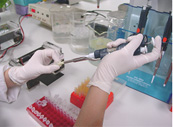


Basic research on vectors and pathogens:
Basic research in this area involves the study of strain diversity and coevolution of vectors, pathogens and symbiotic microbes that have potential for use in future genetic control programs. Such study will provide baseline data for future application of genetic engineering technologies to natural vector populations. Other baseline research on vectors and vector-borne pathogens include drug resistance, insecticide resistance, disease prevalence, pathogenesis and immunogenesis as well as postgenomic analysis of disease vectors and pathogens.
Invention and evaluation of vector control methodologies:
This area of research ranges from the development of appropriate technologies at the community level to molecular-based technologies for use in future vector control approaches. The goal of research is to improve current community-based vector control technologies as well as to apply advanced molecular technologies such as genetic engineering to decrease the ability of disease vectors in transmitting pathogens to humans. Current molecular research aims to develop a system to express foreign genes in disease vectors and to develop a system to deliver these genetically engineered vectors into natural vector populations. Available biological control technologies are being investigated both in the laboratory and in the field.
Molecular ecology of malarial parasites and their vectors:
This project aims to investigate the molecular ecology, population structure and epidemiology of malarial parasites and their Anopheles mosquito vectors in different areas of Thailand bordering Cambodia and Myanmar. Cloning and sequencing of microsatellites and antigen loci of Plasmodium parasites and the development of microsatellite markers for Anopheles vectors are being conducted. Data will be used to determine population structure and coevolution of these parasites and their hosts.
Monitoring of insecticide resistance and mapping of malaria vectors:
: A monitoring system is being set up to detect the early development of insecticide resistance. We are developing molecular and biochemical tests to explore the resistance mechanism involved. A Geographic Information System (GIS) on vector distribution and insecticide resistance and a model to predict vector distributions and associations with environmental factors are being developed. This will be a practical tool to delineate malaria risk areas and, thus, improve the targeting of vector control and the assessment of vector resistance status.
Postgenomic analysis of malaria parasites:
Diagnosis of malaria is generally done by examination of Giemsa's stained thick and thin films of peripheral blood smear under microscope. However, malaria may be misdiagnosed as its clinical symptoms could be confused with a number of other diseases. The advance in DNA technology has resulted in development a more precise diagnosis based on PCR technology. The availability of genome sequence information in Plasmodium falciparum has provided foundation for future studies of this organism, with the ultimate goals to identify new important compounds for antimalarial drugs and potential targets for vaccine.
Mechanism of antimalarial drug resistance:
There are only a limited number of drugs which are still effective and can be used to treat malaria. The most widely used drugs are quinine and its derivatives and the antifolate combination drugs. Sulfadoxine-Pyrimethamine (SP) combination is considered to be another first-line antimalarial drug in several countries where chloroquine resistant falciparum is widespread. Unfortunately, SP is particularly prone to rapid emergence of resistance. Recently, a new anti-malarial drug called artemisinin has been developed using an extract of the Artmisinin annua herb long used in China to treat malaria. Artemisinin is now being used as a front-line treatment in Southeast Asia and South America where resistance to all the other drugs is prevalent. Our major goal is to study the mechanism of drug resistance in these antimalarial drugs.
Development of a dengue vector control and surveillance system:
: This project aims to develop a cost-effective dengue vector control model for rural communities. We hypothesize that suppression of dengue vectors at foci within a village and in schools will effectively reduce dengue transmission throughout the community. The identification of foci involves an integration of serosurvey and spatial GIS mapping of the study area. The vector control methodologies are an environmental-friendly, integrated, community-based approaches. The success of our vector control effort is measured by comparing both entomological and serological parameters. In addition, prediction of dengue risk areas using GIS and remote sensing is being conducted.



Characterization and genetic engineering of densoviruses for vector control:
Surveying for novel strains of densoviruses in different mosquito species, mainly of the genera Aedes, Anopheles and Culex, is currently conducted. Densoviruses found in different mosquito species are isolated and characterized. Complete genome sequencing of these viruses is currently carried out. Infectivity and vertical transmission of these densoviruses are being investigated in mosquito vectors in order to map the genes responsible for virulence, infectivity, vertical transmission and other viral properties. The ultimate goal of this project is to genetically engineer densoviruses to express transmission-blocking genes in mosquito vectors.
Biology of Wolbachia symbionts and potential application in genetic control:
The intracellular, maternally-inherited Wolbachia bacteria have been proposed as a means to spread desirable genes into natural vector populations. Our project aims at studying strain diversity and various effects of Wolbachia bacteria in their arthropod hosts. The dynamics of Wolbachia infection and the reproductive effect, called cytoplasmic incompatibility, that these bacteria cause in their natural and transinfected mosquito hosts will be investigated to determine the potential application of Wolbachia to vector control. Crustacean-infecting Wolbachia strains are known to cause feminization of genetic male hosts and this property may be useful for cost-effective mass-culturing of commercial or beneficial crustaceans. We will attempt to use this feminizing property of Wolbachia for mass-rearing copepods, which are predators of mosquito larvae, for biological control.
Molecular ecology of ticks and chigger mites and their associated pathogens:
This project aims to determine the spatial distribution and genetic variation of ticks and chigger mites as well as the pathogens transmitted by them. PCR-screening for tick-borne and mite-borne rickettsiae and viruses are currently conducted using various specific primer sets. PCR products of novel positive samples will be cloned and sequenced and the phylogenetic relations among pathogens will be determined. Isolation of pathogens will be attempted in order to confirm infection.
Characterization of dengue virus 5'NCR variants:
Our project aims to gain the better and more basic molecular information of dengue viruses and to pave the way for the improvement of dengue vaccine development. We have constructed mutant cDNA clones at the 5'NCR of dengue-2 (16681) using molecular genetic engineering approach. The cDNA derived viruses are characterized in vitro cell culture and in vivo studied in mouse as well as in the dengue mosquito vector, Aedes aegypti. Evaluation for the stability and vertical transmission of the variant viruses will be performed in the mosquitoes. In addition, the viral transcription and translation will be analyzed. The final goal is to select the best candidate virus that has a high potential for the future vaccine development against dengue virus.
Pathogenesis and immunogenesis of dengue viruses:
Dengue virus infection triggers several intracellular signaling alterations which involved in pathogenesis of dengue hemorrhagic fever or dengue shock syndrome (DHF/DSS). Our studies involve the factors induced by dengue virus infection in human dendritic cells and the pathogenicity of dengue virus in endothelial cells. We emphasize on the significance and association among the intracellular signaling proteins and their pathways that induce DHF/DSS.
Center for Vectors and Vector-Borne Diseases
Chalermprakiat Building, Floor 5
Faculty of Science, Mahidol University,
Rama VI Road, Ratchathewi, Bangkok 10400, Thailand
Tel : (66)-02-201-5922 Fax : (66)-02-201-5923
Center for Vectors and Vector-Borne Diseases
SC2 Building, Room SC2, 2nd Floor Salaya Campus
999 Phuttamonthon 4 Road, Salaya, Nakhon Pathom 73170, Thailand
Tel : (66) 2 441 9816-20 ext. 1180 Fax : (66)2 441 0227